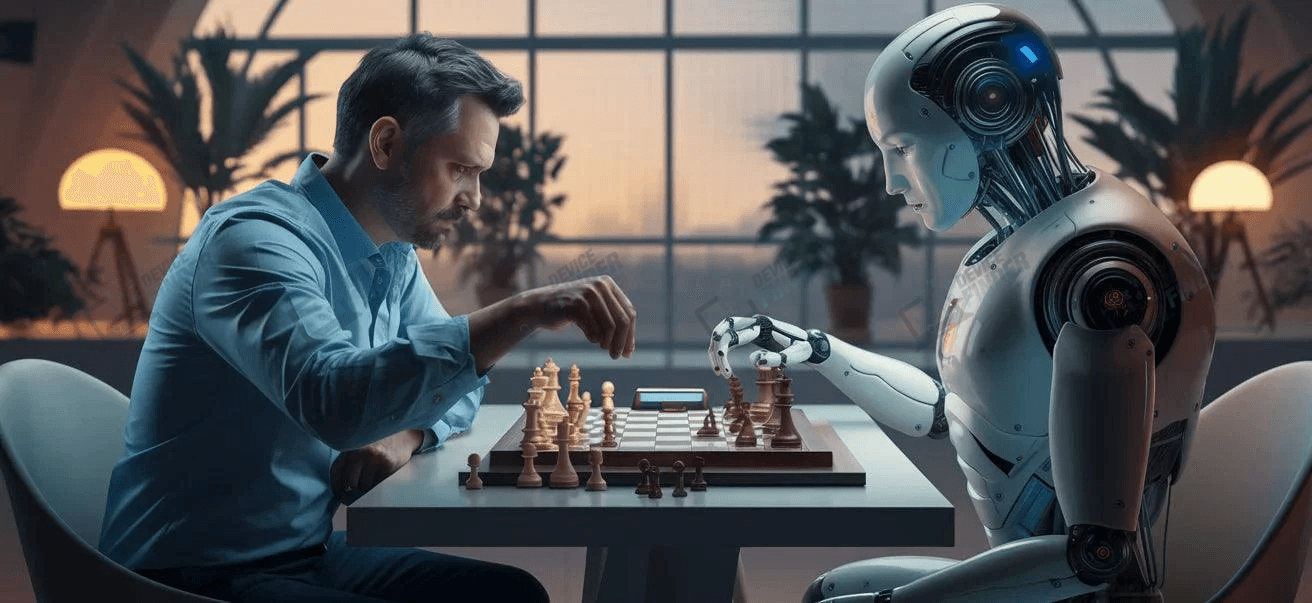
Can Artificial Intelligence Ever Match Human Intelligence?
Human intelligence is a mix of thinking, creativity, emotions, and the ability to adapt. It helps us learn, solve problems, and handle complex situations in life. Unlike artificial intelligence, which works based on algorithms and data, human intelligence is intuitive and can understand context, morals, and abstract ideas. AI can copy some thinking tasks quickly and accurately, but the depth, awareness, and emotions of humans are still unmatched. Comparing human and artificial intelligence makes us think about the future of learning, decision-making, and how humans and machines will work together.
The Timeless Question of Intelligence
In 2025, the debate about whether AI can match human intelligence is stronger than ever. After looking at global AI developments, one thing is clear: machines are very fast, accurate, and good at recognizing patterns. But human intelligence uses creativity, intuition, and ethics in ways machines cannot copy. The future of AI is not to replace humans, but to work together with us.
AI is helping many industries with features like predictive analytics, natural language processing, and adaptive learning. From finance to healthcare, these systems can handle huge amounts of data faster than humans. Still, real intelligence requires an understanding of context, emotions, and consequences, and humans are still the best at that.
Understanding Human Intelligence
What makes human intelligence special?
Human intelligence mixes thinking, understanding feelings, creativity, and self-awareness. Unlike machines, humans can make decisions in unclear situations, predict outcomes, and learn from a few experiences. This flexibility is very important for solving problems in changing situations.
The main parts of human intelligence are:
- Cognitive flexibility: The ability to switch between tasks and think in different ways.
- Emotional intelligence: Understanding and responding to emotions well.
- Creativity: Coming up with new ideas and solutions.
- Ethical reasoning: Making fair and moral decisions with care and understanding.
Even with modern AI, these abilities are important for leadership, innovation, and progress. Human intelligence mixes logic and emotions naturally.
What Defines Artificial Intelligence?
Artificial Intelligence means machines that are made to do tasks which usually need human intelligence. Today’s AI uses algorithms, neural networks, and deep learning to copy some human thinking abilities.
Types of AI:
- Narrow AI (ANI): Can do specific tasks like recognizing images, translating languages, or predicting things.
- Artificial General Intelligence (AGI): Aims to have human-like intelligence in many different areas.
- Superintelligent AI (ASI): A theoretical AI that could be smarter than humans in all ways.
Right now, ANI is common and widely used. AGI is still in the research stage. Scientists are working to make AI that can learn in context, adapt on its own, and think across different areas. Experts believe AGI might appear in the next 20 years, but there are still big ethical, technical, and legal challenges to solve.
Key Differences Between Human and Artificial Intelligence
Can AI think like humans? The short answer is no, but it can simulate aspects of human reasoning.
|
Features |
Human Intelligence |
Artificial Intelligence |
|
Creativity |
High-context, context-driven |
Limited, pattern-based |
|
Emotion |
Present, adaptive |
Absent, simulated |
|
Learning |
Experiential, intuitive |
Data-driven, statistical |
|
Ethics |
Contextual, situational |
Pre-programmed, rule-based |
|
Problem-solving |
Flexible and innovative |
Constrained by algorithms |
Humans can understand unclear situations and make plans even when things are uncertain. AI works with organized data and cannot understand emotions. While AI helps improve work efficiency, it cannot replace the deep thinking that humans naturally have.
The Rise of Machine Learning and Neural Networks
How do AI systems learn?
AI systems learn using machine learning and neural networks. These help AI find patterns, make predictions, and make better decisions. For example:
- Healthcare: AI looks at medical images to find tumors earlier than usual methods.
- Finance: AI predicts market trends and helps reduce risks.
- Retail: AI suggests products to customers by studying their shopping habits, which helps increase sales.
AI systems work with huge amounts of data and learn step by step. Neural networks are designed like the human brain but do not have awareness or feelings. AI can predict some things, but it cannot fully understand human thoughts or intentions.
Can Machines Think or Just Simulate Thinking?
Philosophers and computer scientists have long discussed whether machines can really think. AI can imitate thinking using algorithms, but true understanding needs consciousness, intention, and personal experience.
Some important points are:
- The Turing Test: Created by Alan Turing, this test checks if a machine’s behavior looks like a human’s. Passing the test shows the machine can imitate thinking, but it does not mean it truly thinks.
- Chinese Room Argument: This idea says AI can handle symbols and rules very well but does not understand them.
- Practical AI thinking: AI can solve difficult problems, but it does not understand things like humans do.
In today’s AI world, machines help human thinking instead of copying it completely. Ethical rules and regulations make sure AI improves our decisions without going beyond what it can really do.
Areas Where AI Already Surpasses Human Intelligence
AI works best in areas that need fast calculation, accuracy, and speed. Some real-life uses are:
- Data Analysis: AI can look through millions of records in seconds.
- Predictive Maintenance: In factories, AI can predict machine problems before humans notice them.
- Autonomous Vehicles: AI analyzes sensors in real-time to reduce accidents and manage traffic better.
- Healthcare Diagnostics: AI helps doctors spot problems in scans faster than traditional methods.
These examples show how AI can help humans do their work better. But machines do not have feelings, intuition, or the ability to make ethical decisions. Their intelligence works only in specific areas and depends on the data they are given.
Where AI Still Fall Behind Humans?
Despite progress, AI cannot copy important human abilities.
- Creativity: Machines can make new versions of existing ideas but cannot imagine completely new things.
- Ethical Thinking: AI follows rules set by humans and cannot decide on tricky moral questions.
- Emotional Understanding: Humans connect using feelings, intuition, and emotional signals, which AI cannot truly do.
- Adaptability: Humans can adjust and act in uncertain situations, while AI needs clear instructions.
The human brain combines experience, emotions, and social understanding, which AI cannot genuinely copy.
Future Possibilities: Towards Artificial General Intelligence (AGI)
AGI tries to copy human-like thinking in many areas. Research focuses on:
- Contextual learning: Understanding different situations without needing to be retrained.
- Adaptive reasoning: Making decisions even when information is incomplete.
- Working with humans: Helping people work better and make smarter decisions.
AGI could change many industries, but reaching real human-level intelligence would require new ideas about consciousness, emotions, and ethics. Today, AI is a powerful tool; in the future, it could become a helpful partner.
Final Thoughts
AI cannot fully match human intelligence, but it can support human abilities. In a human-focused AI world, people can concentrate on creativity, ethics, and smart decision-making, while machines handle tasks that need lots of data. The growth of AI, from predicting trends to running autonomous systems, helps humans work better, not replaces them.
The future of AI is about working together, improving human thinking, and creating value for society. By knowing what AI cannot do, we can use its strengths while keeping the abilities that only humans have. AI will never replace human intelligence, but together, humans and machines can achieve amazing innovation.









